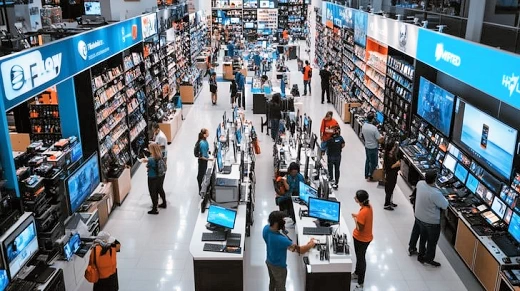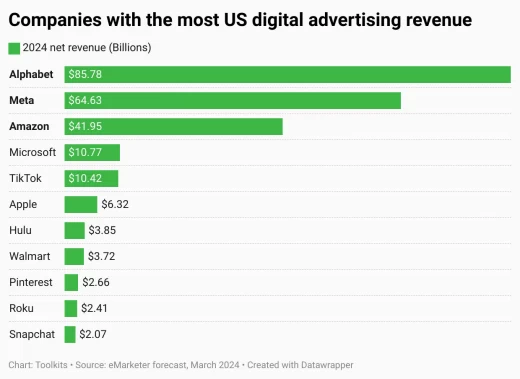Google Ads to Sustain Business in Challenging Economic Times
Recent Events
As we entered 2025, US consumer confidence and stock prices soared on expectations that the result of the presidential election would ensure that a combination of tax cuts and deregulation would boost economic growth, corporate profits and household incomes. A recession had been avoided, inflation was nearing the Federal Reserve's target level, wages had grown above pre-COVID levels, consumer spending exceeded economists' predictions, and business investment was at record levels.
But with the end of the first quarter coming up, most of the economic news has focused on tariffs that are expected to result in inflation, tighter money, supply chain interruptions and cutbacks on consumer spending. Uncertainty over tariffs is now the biggest driver of the economy. An expectation is developing that the US economy will soon begin to slow down or actually contract. Investors are shifting funds away from equities toward lower-risk assets.
A reported 93% decline in immigration to the USA since the end of 2024 has resulted in a small increase in the unemployment rate, but a significant drop in the number of people actively working in the US. If that trend continues, as competition of businesses for workers heats up, wages and prices will rise, contributing to further inflation.
What's next?
- Proposed cuts in government spending - on things like the Affordable Care Act and the US Department of Education - will likely soon be offset by spending elsewhere.
- Because of the threat of further inflation, the Federal Reserve will defer any further interest rate cuts until at least the second quarter of 2025. A strong job market and robust consumer spending should make deferring rate cuts less of a problem. But government layoffs could change that.
- Consumers and businesses will likely drive up US foreign trade activity by 3%-4% early in 2025 to avoid price increases due to new tariffs.
- US business investment has been at a record high since the passage of legislation that has stimulated US production of strategic technologies like EVs, batteries and semiconductors. But because many of the imported goods to which new tariffs may apply are used as inputs by US industries, those firms' cost of doing business will increase. Those unable to find a cost-effective local replacement source could fail.
How can you continue to get customers and sales in today's economy?
 As soon as inflation rose to a 40-year high in 2022 and the Fed began raising interest rates - making monthly mortgage and credit-card payments higher for consumers carrying balances - people began to spend more judiciously on discretionary goods and services. But they haven't, and won't, STOP spending.
As soon as inflation rose to a 40-year high in 2022 and the Fed began raising interest rates - making monthly mortgage and credit-card payments higher for consumers carrying balances - people began to spend more judiciously on discretionary goods and services. But they haven't, and won't, STOP spending.
However, at the first sign of a pullback in consumer spending, many business owners panic. Their first thought is to bring marketing in-house, stop advertising and hunker down until the economy recovers.
First marketing efforts to go are typically those that don't produce a measurable return on investment: content marketing, image advertising, social media, branding.
Smaller advertising platforms like X, Snap and TikTok will be hit harder than Google because they have a smaller ad sales volume, and big advertisers consider their efficacy, safety and scalability to be largely unproven. Advertisers go where their audiences are, and more are at Google than anywhere else.
 Google alone has demonstrated over a significant period of years the consistent ability of its advertising programs to get buyers to the bottom of the funnel, and for that reason, savvy advertisers won't be switching horses in the economic climate of 2025. Advertising money will continue to rush to Google.
Google alone has demonstrated over a significant period of years the consistent ability of its advertising programs to get buyers to the bottom of the funnel, and for that reason, savvy advertisers won't be switching horses in the economic climate of 2025. Advertising money will continue to rush to Google.
However: in 2024, many American consumers lost faith in the Biden administration's ability to manage the economy effectively. Interest rates rose, people cut back on spending, and advertisers found themselves chasing fewer buyers. Accordingly, average Google Ads costs across all industry sectors increased by 10.4% vs. 2023. When Google click prices became insanely overinflated so that very high ad spends are required to get conversions, some businesses stopped advertising altogether or tried to maintain sales by switching their ad spend to lower-priced media.
When that happens, if you've hung in there with Google Ads, you'll be able to get lower-priced leads and more conversions as a result of decreased competition.
 If you're tempted to stop advertising in 2025 - or not ever to start it - consider the conclusions reached by Henry Ford after his company lost $88 million - nearly $20 billion in 2025 dollars - in the Great Depression of 1932-33:
If you're tempted to stop advertising in 2025 - or not ever to start it - consider the conclusions reached by Henry Ford after his company lost $88 million - nearly $20 billion in 2025 dollars - in the Great Depression of 1932-33:
“The way out of the depression is to start spending and doing things.”
“A man who stops advertising to save money is like a man who stops a clock to save time.”
The key thing is: to do whatever it takes to keep your Google Ads running through the bad times so you can stay in business, continue to get new customers into your pipeline, and get ahead of competitors in the upturn.
